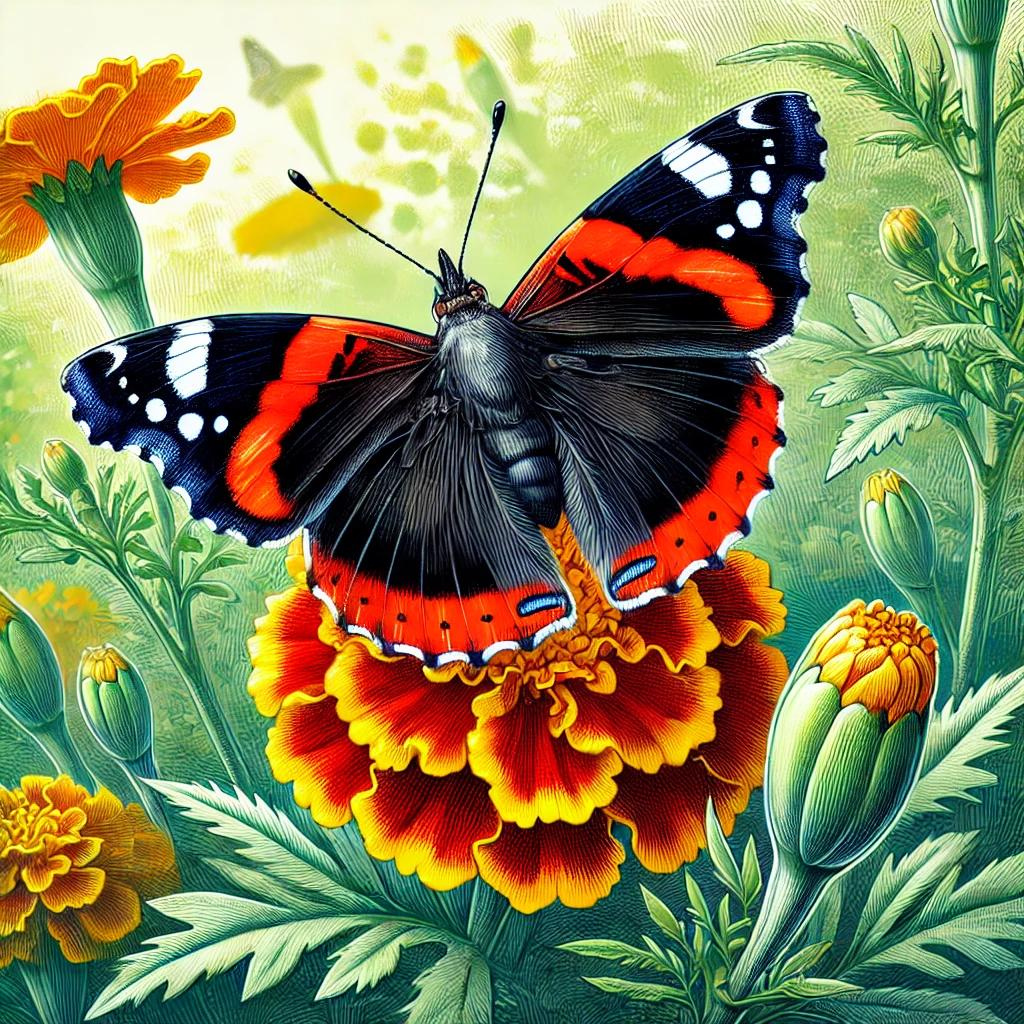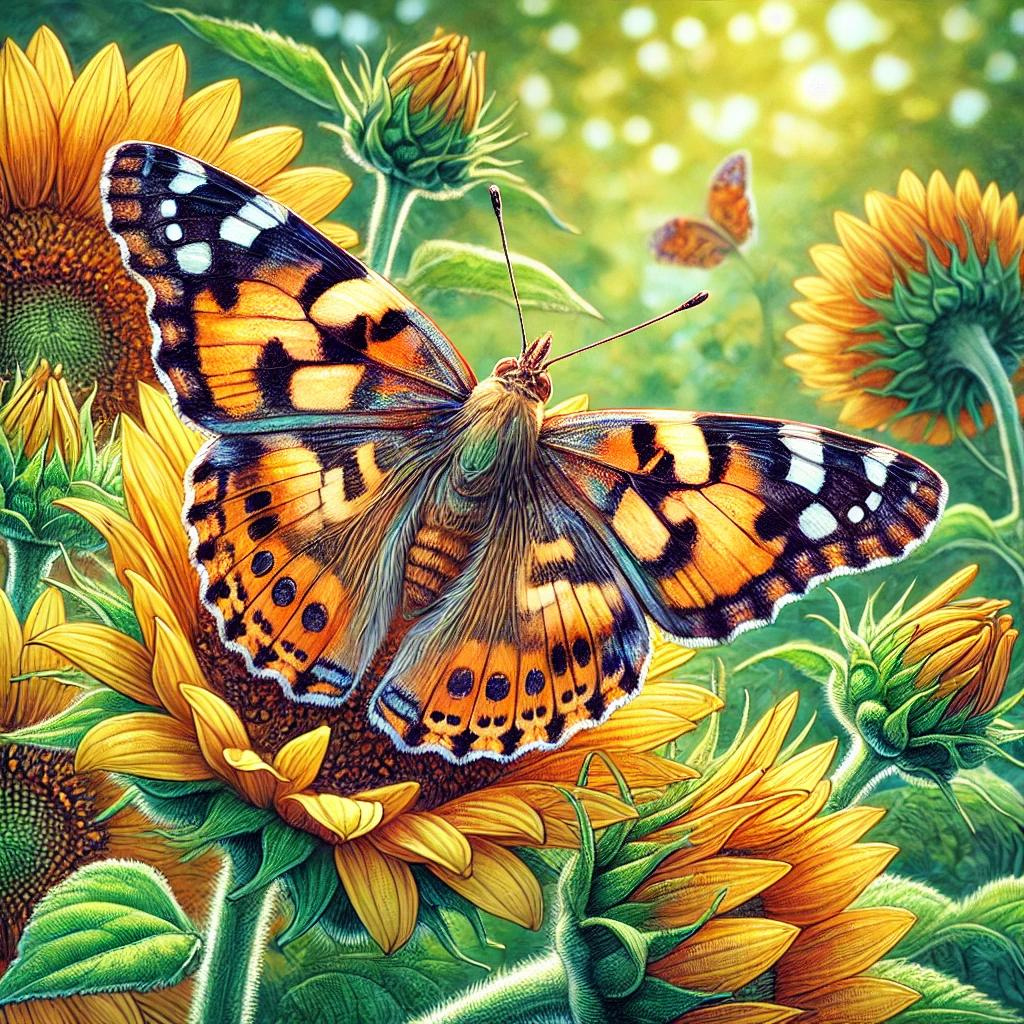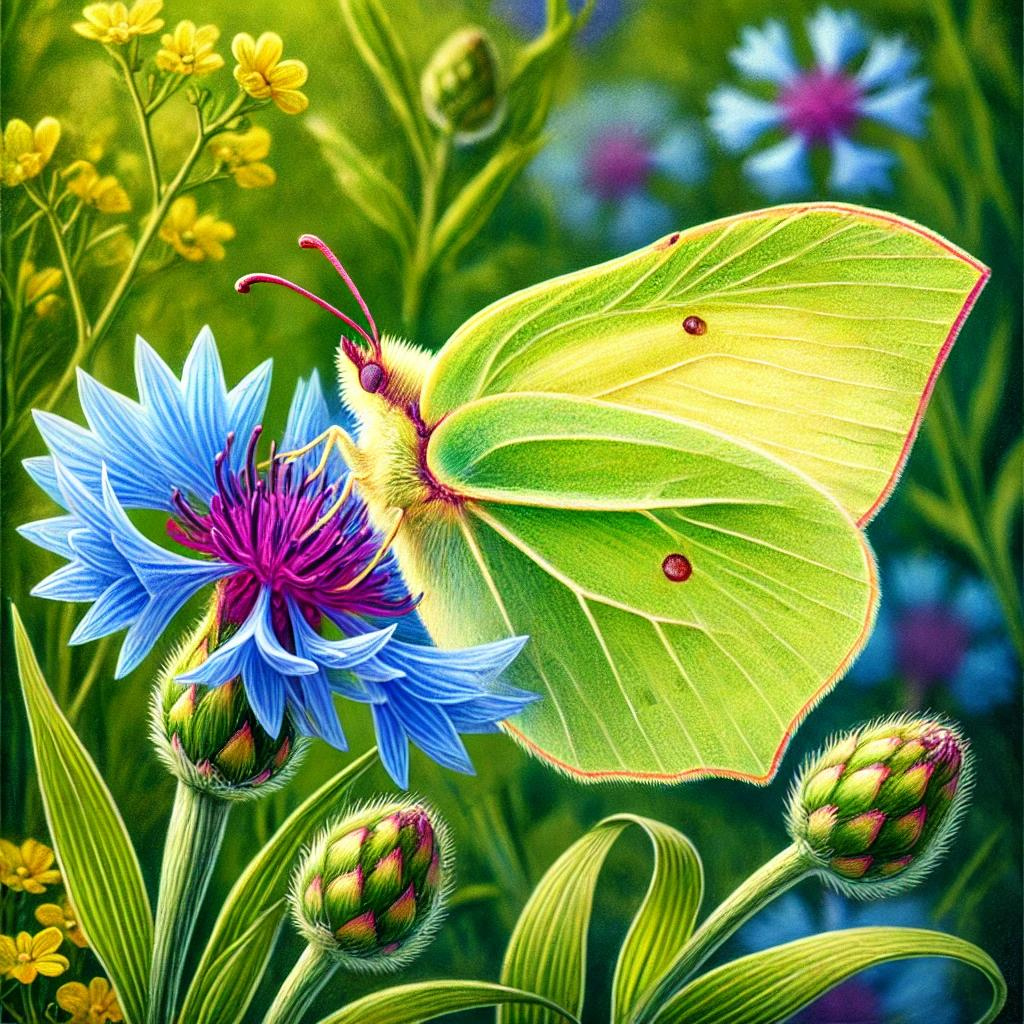Common British Garden Butterflies
Butterfly Species
Red Admiral

The Red Admiral (Vanessa atalanta) is a striking butterfly with black wings adorned with red bands and white spots. These butterflies are commonly seen from spring to autumn. They are attracted to nectar-rich flowers such as buddleia and ivy. Red Admirals prefer sunny, sheltered spots and are often found in gardens, parks, and woodland edges.
Peacock

The Peacock butterfly (Aglais io) is easily recognisable by its eye-catching eye spots on each wing, which serve to deter predators. Peacocks are frequently seen basking in the sun during warm weather. They are present from early spring to late summer, with a second generation often appearing in autumn. They favour nettles as caterpillar host plants and nectar sources like buddleia and thistles.
Small Tortoiseshell

The Small Tortoiseshell (Aglais urticae) is a familiar garden visitor, known for its orange and black patterned wings with blue spots along the edges. These butterflies are one of the first to emerge in spring and can be seen until late summer. Small Tortoiseshells lay their eggs on nettles, and the adults are drawn to a variety of flowers, including marjoram and lavender.
Painted Lady

The Painted Lady (Vanessa cardui) is a migratory butterfly with distinctive orange, black, and white markings. They arrive in the UK in varying numbers each year, usually from late spring to autumn. Painted Ladies are highly mobile and can be found in a range of habitats, including gardens, meadows, and coastal areas. They prefer nectar sources such as thistles, buddleia, and knapweed.
Brimstone

The Brimstone (Gonepteryx rhamni) is often considered the harbinger of spring, with its lemon-yellow wings that are unmistakeable in flight. Males are brighter yellow, while females are paler, almost white. Brimstones hibernate as adults and emerge in early spring, often seen in woodlands, gardens, and hedgerows. Their caterpillars feed on buckthorn and alder buckthorn, while the adults seek nectar from primroses, bluebells, and knapweed.
Seasonal Appearances and Preferred Habitats
Each butterfly species has its own seasonal patterns and preferred habitats, making it important to provide a variety of plants and environments to support their lifecycles. By understanding these patterns and planting the right flowers and host plants, you can create a welcoming habitat that attracts these beautiful creatures to your garden year after year.
Avoid Spraying to Help Caterpillars
The Impact of Pesticides
Pesticides can have devastating effects on caterpillars and butterflies. These chemicals are designed to eliminate pests, but they do not discriminate, often harming beneficial insects as well. Caterpillars, the larval stage of butterflies, are particularly vulnerable to pesticides. Exposure can lead to their death or deformities, preventing them from maturing into butterflies. Furthermore, the reduction in caterpillar populations directly impacts butterfly numbers, as there are fewer individuals reaching adulthood.
Alternatives to Chemical Sprays
To protect caterpillars and butterflies, it is essential to explore alternatives to chemical sprays. Organic gardening practices offer effective ways to manage pests without harming beneficial insects. For example, using neem oil, insecticidal soaps, and homemade remedies like garlic spray can help control pest populations while being less toxic to caterpillars and butterflies. Additionally, introducing beneficial insects such as ladybirds and lacewings can naturally reduce pest numbers, creating a balanced ecosystem in your garden.
Creating a Safe Environment
Encouraging Natural Predators
One of the best ways to maintain a healthy garden without pesticides is by encouraging natural predators. Birds, spiders, and predatory insects can help control pest populations. Providing bird feeders, bird baths, and nesting boxes can attract birds to your garden, where they will help keep caterpillar predators in check.
Planting a Variety of Native Plants
Planting a diverse range of native plants can create a resilient garden ecosystem. Native plants are well-adapted to the local environment and provide essential resources for butterflies and other wildlife. They support a variety of insects, which in turn attract predators that help manage pest populations naturally. Incorporating native flowering plants, shrubs, and trees will not only enhance the beauty of your garden but also provide food and shelter for butterflies and caterpillars.
Practical Tips for Maintaining a Pesticide-Free Garden
Maintaining a pesticide-free garden requires some effort and vigilance, but the rewards are worth it. Regularly inspect your plants for signs of pests and remove them by hand when possible. Use barriers like row covers to protect young plants from insect damage. Mulching and proper watering can strengthen plants, making them more resistant to pests. By adopting these practices, you can create a safe haven for caterpillars and butterflies, ensuring a thriving butterfly population in your garden.
Lifecycle of a Butterfly
Stages of Development
Butterflies undergo a fascinating transformation through four distinct stages:
- Egg
- Caterpillar (Larva)
- Chrysalis (Pupa)
- Adult Butterfly
Detailed Description
Egg
The lifecycle begins when a female butterfly lays her eggs, usually on the leaves of host plants. These eggs are tiny, often no larger than a pinhead, and can vary in colour and shape depending on the species. The egg stage can last from a few days to a couple of weeks, depending on the temperature and species.
Caterpillar (Larva)
Once hatched, the caterpillar emerges, ready to eat. This stage is primarily about growth, and caterpillars can increase their body mass hundreds of times over. They are often characterised by their segmented bodies and the voracious appetite for their host plant. This stage can last from a few weeks to a month. During this time, caterpillars will moult, or shed their skin, several times as they grow.
Chrysalis (Pupa)
The caterpillar then forms a chrysalis, also known as a pupa. This stage is a period of remarkable transformation. Inside the chrysalis, the caterpillar's body undergoes metamorphosis, reorganising into the structure of an adult butterfly. This stage can vary greatly in duration, from a couple of weeks to several months, depending on environmental conditions and species.
Adult Butterfly
Finally, the fully formed butterfly emerges from the chrysalis. Initially, its wings are soft and crumpled, and the butterfly will spend some time pumping fluid into its wings to expand and harden them. Once ready, the butterfly will take flight, searching for food, mates, and places to lay eggs, thus beginning the cycle anew. The adult stage can last from a few weeks to several months, depending on the species and environmental factors.
Visual Aids
Incorporating diagrams or visual aids can greatly enhance understanding of the butterfly lifecycle. Illustrations showing each stage of development can provide clear, visual representation of the transformation from egg to adult butterfly, highlighting the incredible changes that occur during each phase.
How Long Butterflies Live
Lifespan of Different Species
The lifespan of butterflies can vary significantly depending on the species. Common British butterflies, such as the Red Admiral and Small Tortoiseshell, typically live for a few weeks as adults. For example, the Painted Lady can live for about 2-4 weeks, while the Peacock butterfly may survive for up to 4-6 weeks under favourable conditions. Factors such as availability of food, weather conditions, and predation play a crucial role in determining how long a butterfly will live.
Factors Affecting Butterfly Longevity
Several factors influence the longevity of butterflies. The most critical factor is the availability of nectar-rich flowers, which provide essential nourishment. Additionally, weather conditions such as temperature and humidity can impact their lifespan. Warmer temperatures generally accelerate the lifecycle, leading to a shorter adult phase, whereas cooler climates can prolong their lives. Predation by birds, spiders, and other insects also affects how long butterflies can survive. Furthermore, human activities, including habitat destruction and pesticide use, can significantly reduce their lifespan.
Seasonal Variations
The lifespan of butterflies also varies with the seasons. Summer butterflies, which emerge in the warmer months, usually have shorter lifespans due to the accelerated development of their life stages in the heat. These species, such as the Common Blue and Large White, often live for only a few weeks as adults. In contrast, butterflies that overwinter, like the Brimstone and Peacock, can live much longer. These species enter a state of dormancy during the colder months and can survive for several months, emerging again in spring to continue their lifecycle.
By understanding the factors that affect butterfly longevity and the differences in their seasonal lifespans, gardeners can create environments that support these beautiful insects throughout their entire life cycle. This not only aids in butterfly conservation but also enhances the diversity and vibrancy of the garden.
Butterfly Species in Decline
Endangered Species
Several butterfly species in the UK are experiencing significant declines. Among the most endangered are the High Brown Fritillary, the Wood White, and the Duke of Burgundy. These species have seen dramatic reductions in their populations due to various environmental challenges. The High Brown Fritillary, once widespread, is now confined to a few isolated sites. The Wood White, known for its delicate and slow flight, is also in serious decline. The Duke of Burgundy, a small and striking butterfly, faces similar threats and is now found in limited locations.
Causes of Decline
The decline of these butterfly species can be attributed to several key factors:
-
Habitat Loss: Urbanisation, intensive farming, and changes in land use have led to the destruction of natural habitats essential for butterflies. Woodland clearings, grasslands, and hedgerows have diminished, reducing the availability of food plants and breeding sites.
-
Climate Change: Changes in climate patterns affect the availability of suitable habitats and alter the lifecycle timing of butterflies. Extreme weather events, such as prolonged droughts or heavy rainfall, can also directly harm butterfly populations.
-
Pollution: Pesticides and other pollutants negatively impact butterflies at various stages of their lifecycle. Chemical sprays not only kill caterpillars but also reduce the availability of nectar-rich flowers needed by adult butterflies.
Conservation Efforts
Efforts to conserve these declining butterfly species are crucial. Gardeners can play a significant role in supporting butterfly conservation by creating butterfly-friendly gardens. This includes planting a variety of native plants that provide nectar and host plants for caterpillars. Avoiding the use of pesticides and promoting organic gardening practices are also vital steps.
Several organisations are actively involved in butterfly conservation in the UK. Butterfly Conservation is a leading charity dedicated to saving butterflies, moths, and their habitats. The Royal Horticultural Society (RHS) also promotes gardening practices that benefit wildlife, including butterflies. By supporting these organisations and participating in citizen science projects, individuals can contribute to the protection and recovery of endangered butterfly species.
In conclusion, the decline of butterfly species such as the High Brown Fritillary, Wood White, and Duke of Burgundy is a pressing environmental issue. However, through dedicated conservation efforts and mindful gardening practices, it is possible to help reverse these declines and ensure that butterflies continue to grace our gardens and natural landscapes.
Encouragement to Plant Butterfly-Friendly Gardens
Creating a butterfly-friendly garden is a rewarding endeavour that benefits both the environment and the gardener. By planting a variety of nectar-rich and host plants, you can provide a habitat that supports the entire lifecycle of butterflies. Avoiding harmful pesticides and adopting organic practices will create a safe and thriving environment for these delicate creatures. The presence of butterflies can enhance the beauty and ecological balance of your garden, offering endless opportunities for observation and enjoyment.
Final Thoughts on the Importance of Butterfly Conservation
Butterfly conservation is crucial for maintaining biodiversity and ecological health. Butterflies are important pollinators and indicators of a healthy environment. By taking steps to attract and support butterflies in your garden, you are contributing to the preservation of these enchanting insects. Observing butterflies as they flutter among the flowers is a simple yet profound joy that connects us to nature. Embrace the opportunity to make a positive impact on butterfly populations and enjoy the myriad benefits they bring to your garden.
Together, we can ensure that future generations continue to experience the beauty and wonder of butterflies in our gardens.
If you would like to follow up on this or any other gardening or landscaping topic then please do get in touch





